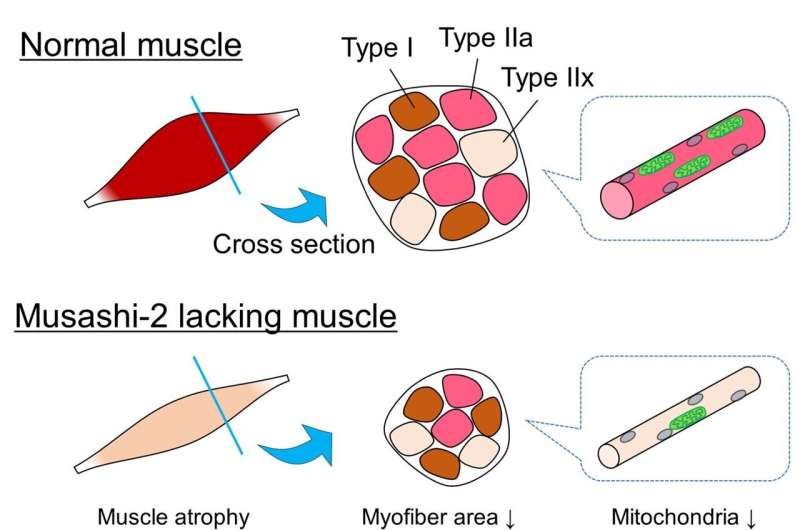This article has been reviewed according to Science X's editorial process and policies. Editors have highlighted the following attributes while ensuring the content's credibility:
fact-checked
peer-reviewed publication
trusted source
proofread
Scientists investigate protein that controls skeletal muscle composition

Researchers from Tokyo Metropolitan University have shown that the protein Musashi-2 (Msi2) plays a key role in the regulation of mass and metabolic processes in skeletal muscle. They studied mice with the Msi2 gene knocked out and found reduced muscle mass due to fewer type 2a muscle fibers. Myoglobin and mitochondria were also reduced. Type 2a fibers respond sensitively to training and illnesses; insights into their regulation will prove valuable in new therapies.
Skeletal muscle fibers are truly fascinating in how responsive they are. With training, we can significantly improve muscle mass, strength and endurance. On the other hand, with age or extended periods without exercise, muscle can also atrophy. Not only is that bad for getting around but can cause a whole host of other illnesses. Yet the exact mechanism by which muscle mass and strength are regulated is still not fully understood by scientists.
Now, a team led by Assistant Professor Yasuro Furuichi from Tokyo Metropolitan University have emerged with a key part of the puzzle. In previous work, they found that Musashi-2 (Msi2), a protein originally discovered in nerve cells, was also expressed in skeletal muscle tissue. Muscular atrophy also led to a decrease in the expression of Msi2. Suspecting that Msi2 had a more specific role in the development of muscle fibers, they decided to take a closer look.
First, they took muscle tissue from mice and applied enzymes to isolate the muscle fibers from nerves, blood vessels and fat cells. Analysis confirmed that Msi2 was indeed being expressed from the muscle fibers themselves. Furthermore, on looking at fibers taken from calf muscles, they found Msi2 was most strongly expressed in type 1 or "slow" fibers, fibers with more endurance but less explosive power than their type 2 or "fast" counterparts.
The team also looked at mice with the gene coding for the Musashi-2 protein artificially "knocked out." They found that the calf muscles of Msi2 knockout mice had significantly reduced mass, with a whitish color, and less strength. On looking at fiber types under a microscope, they found that the reduction in mass was due to a drop in the number of type 2a fibers, a type of "fast" fiber that has some of the endurance of "slow" fibers.
They also noted that Msi2 knockout mice were less able to metabolize sugars, much like in diabetes. There were fewer myoglobin and mitochondria, both vital to produce energy in cells. The problem could be "fixed" by expressing Msi2 in "fast" fibers, restoring both myoglobin and protein markers for mitochondria. This highlights how Msi2 regulates proteins associated with sugar metabolism and effectively controls the proportion of different types of fiber in skeletal muscle tissue. Their research is published in The FASEB Journal.
Type 2a fibers are particularly responsive to training and atrophy easily with age. This makes any insights into how they are regulated a key advance in identifying targets for new therapies to combat muscle decline, as well as developing training regimens to improve muscle strength.
More information: Yasuro Furuichi et al, Lack of Musashi‐2 induces type IIa fiber‐dominated muscle atrophy, The FASEB Journal (2023). DOI: 10.1096/fj.202300563R
Journal information: FASEB Journal
Provided by Tokyo Metropolitan University




















